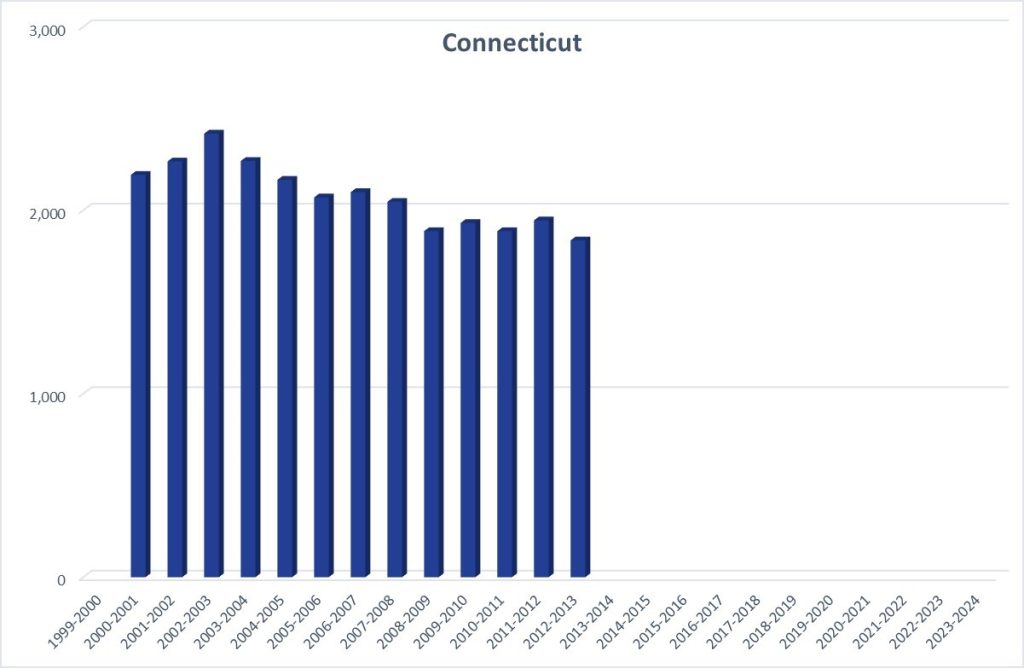While Connecticut used to publicly report homeschool participation, they stopped after 2012, thus little is known about homeschool participation in the state.
History
In the northeastern United States, Connecticut first legalized homeschooling in 1990. The current homeschool law is contained in a 1994 policy. The procedure for homeschooling is “recommended” and not mandatory if the parent can show a child receives an “equivalent education” to what they would receive in the public system.
Regulation
Connecticut supports homeschool families with a homeschool webpage and a free information and resources hub. The state offers one homeschool option, and recommends families who choose to homeschool their children, ages 5 to 18, contact their local district for policies. An intent to homeschool form is recommended but not required. Local districts may ask that parents provide annual proof of learning and meeting instructional requirements. While there are no attendance requirements, the state recommends that parents keep an attendance log of days and hours of instruction. The state also recommends that instruction aligns with the CT Core Standards and provides parents with aligned instructional materials free of charge.
Parents do not need to hold certifications or a high school diploma to homeschool their children. Required subject instruction includes reading, writing, spelling, English grammar, geography, arithmetic, U.S. history, and citizenship. Homeschool students are not required to take an assessment, and the GED is optional.
Connecticut provides no explicit access for nonpublic students to attend local public school courses or to participate in extracurricular activities or sports. As such, some districts may allow access. Boards of education do not have to provide special education services to homeschooled students in Connecticut. Conn. Gen. Stat. §10-184a.
State Data
Since Connecticut does not require reporting, there is little data about homeschool participation. While there is some data up to 2012, it is unclear if it included all homeschooled students or only those who voluntarily reported. Considering the data we do have, homeschool participation in the state ranged from slightly below to slightly over 2,000 students.

According to the participation estimates from the U.S. Census in 2020, approximately 2.5% of families in Connecticut homeschooled during the spring and increased to 7.5% by the fall of 2020. This is much lower than the national average of 11.1% at that time. Based on U.S. Census data, our calculations indicate that about 3.71% of K-12 students in Connecticut were homeschooled during the 2022-23 school year, and 3.01% during the 2023-24 school year. Due to survey changes, the data from 2020 reflects the percentage of households, while the data from following years reflects the percentage of students.
Cross-Sector Comparison
It was not possible to calculate the cross-sector comparison due to missing homeschool enrollment data.
School Choice Context
In addition to homeschooling, parents in Connecticut have various educational choices available. These options include traditional public schools with inter-district and intra-district choice, magnet schools, the Open Choice program that allows students in urban schools to attend suburban schools when seats are available, charter schools, tech schools, and agri-focused schools. There are no publicly funded private school options available for any students in the state.
Commentary
Since filing the annual intent to homeschool form is voluntary, all homeschool families are unlikely to complete it. However, if the districts collect these data from parents, it should be publicly reported. This reporting, while not comprehensive, could improve transparency and provide much-needed information on homeschool trends in the state. Connecticut should provide more opportunities for students to access public school offerings. Connecticut is one of only a dozen states that provides zero access to these educational opportunities for nonpublic students.

-
7.5% Families
Around 7.5% of families in Connecticut homeschooled during the height of the pandemic (Fall 2020).
-
1990 Legalized
Homeschooling was legalized in 1990 in the state of Connecticut.
-

-
More Information
7.5% Families
Around 7.5% of families in Connecticut homeschooled during the height of the pandemic (Fall 2020).
1990 Legalized
Homeschooling was legalized in 1990 in the state of Connecticut.

More Information
Last updated March 2025.